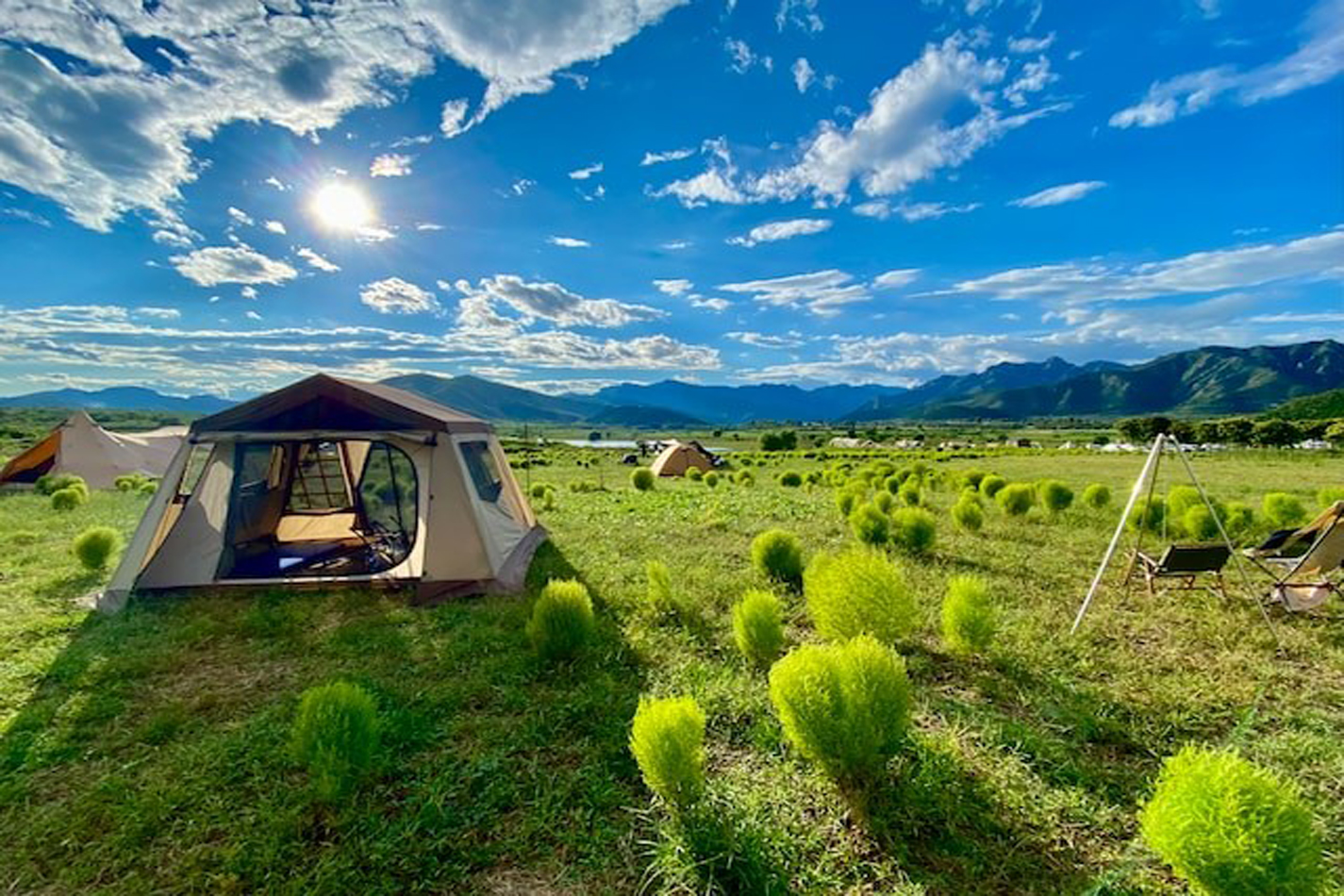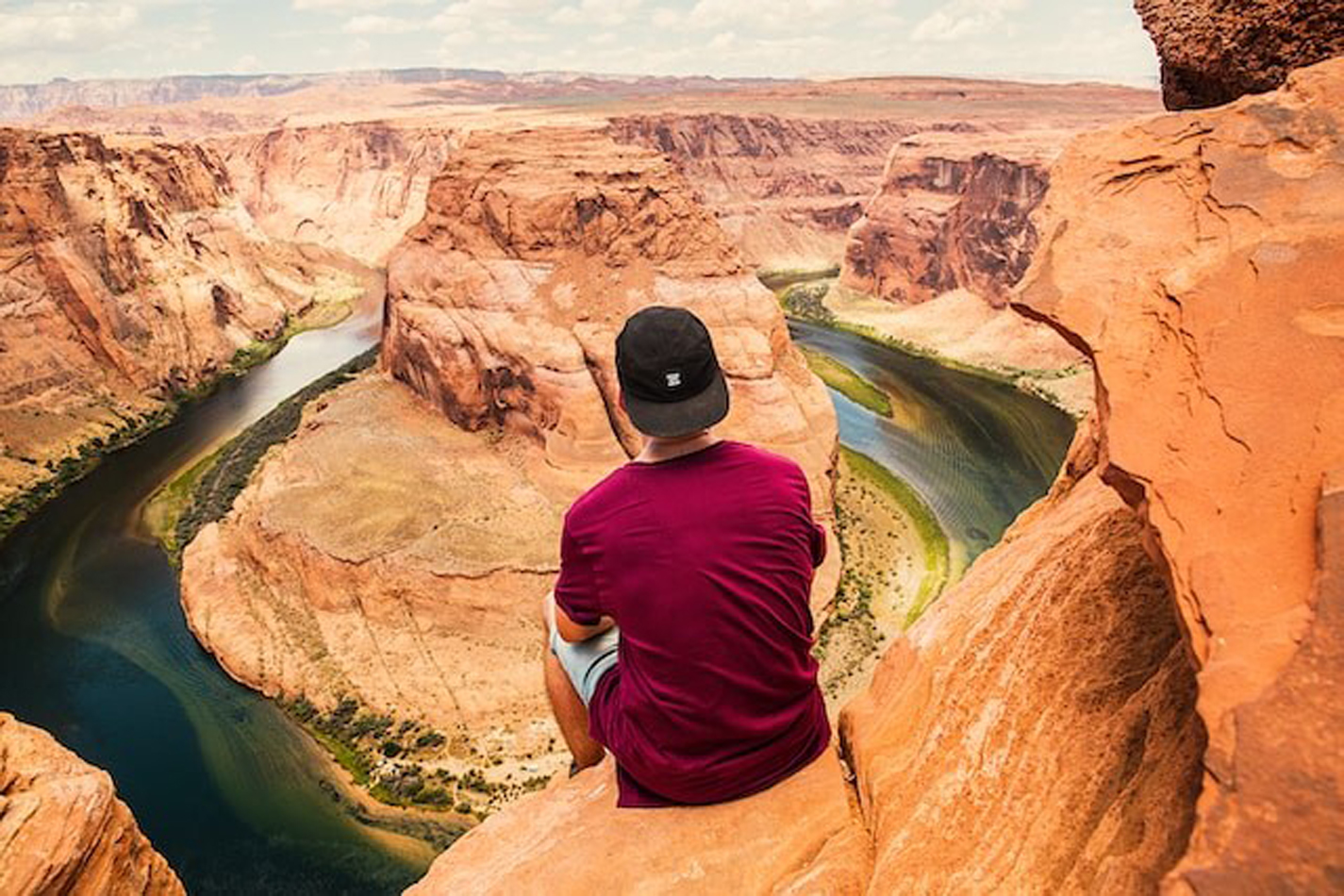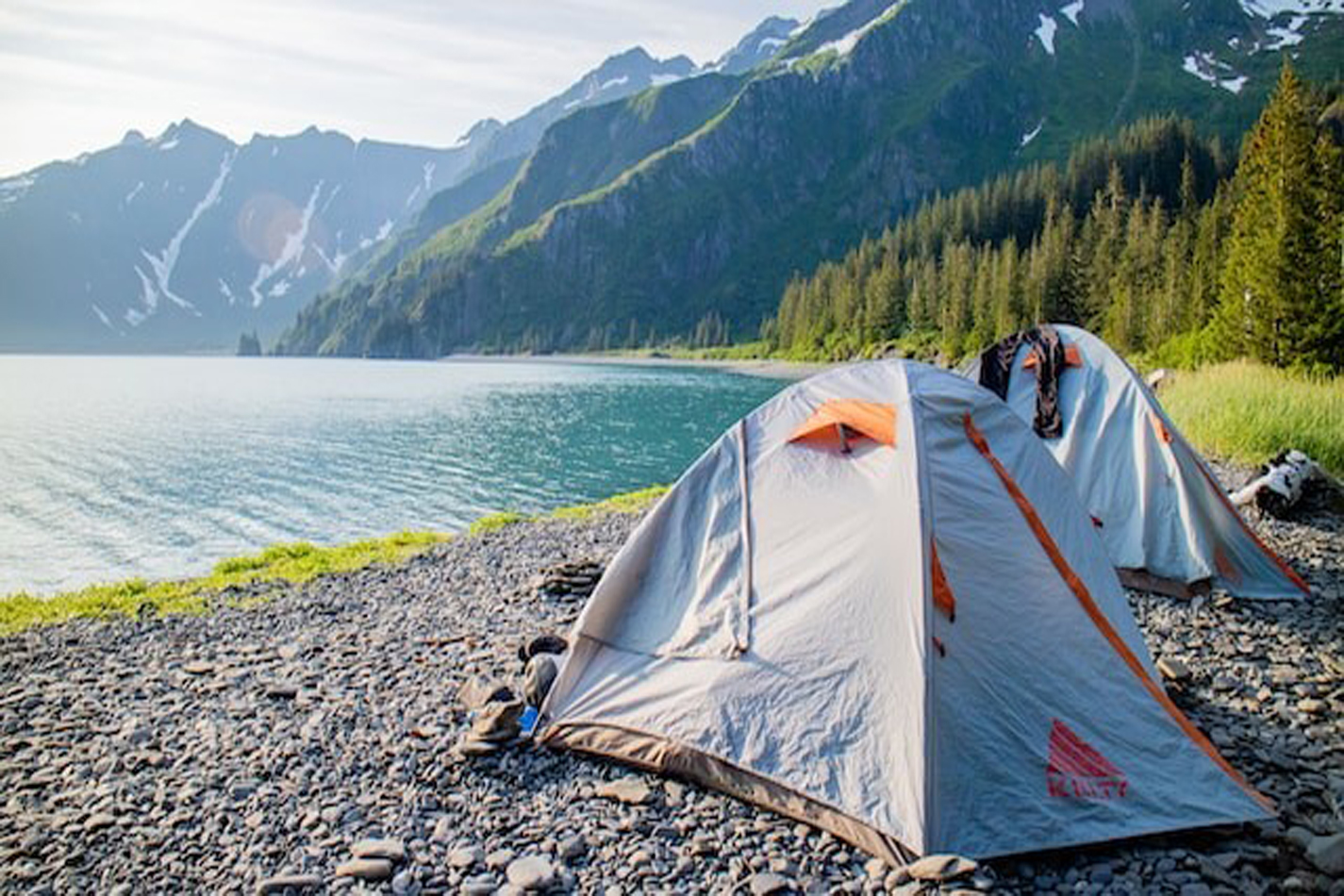Canoe camping is a thrilling outdoor adventure that combines the best of two worlds: the serenity of camping and the excitement of paddling. It involves embarking on a multi-day journey with all your camping gear loaded into a canoe. Unlike traditional camping, where you set up a base at a single location, canoe camping allows you to explore a variety of campsites, each nestled along different shorelines or riverbanks.
In a typical canoe camping trip, you'll navigate serene rivers, tranquil lakes, or meandering waterways, making your way from one campsite to the next.
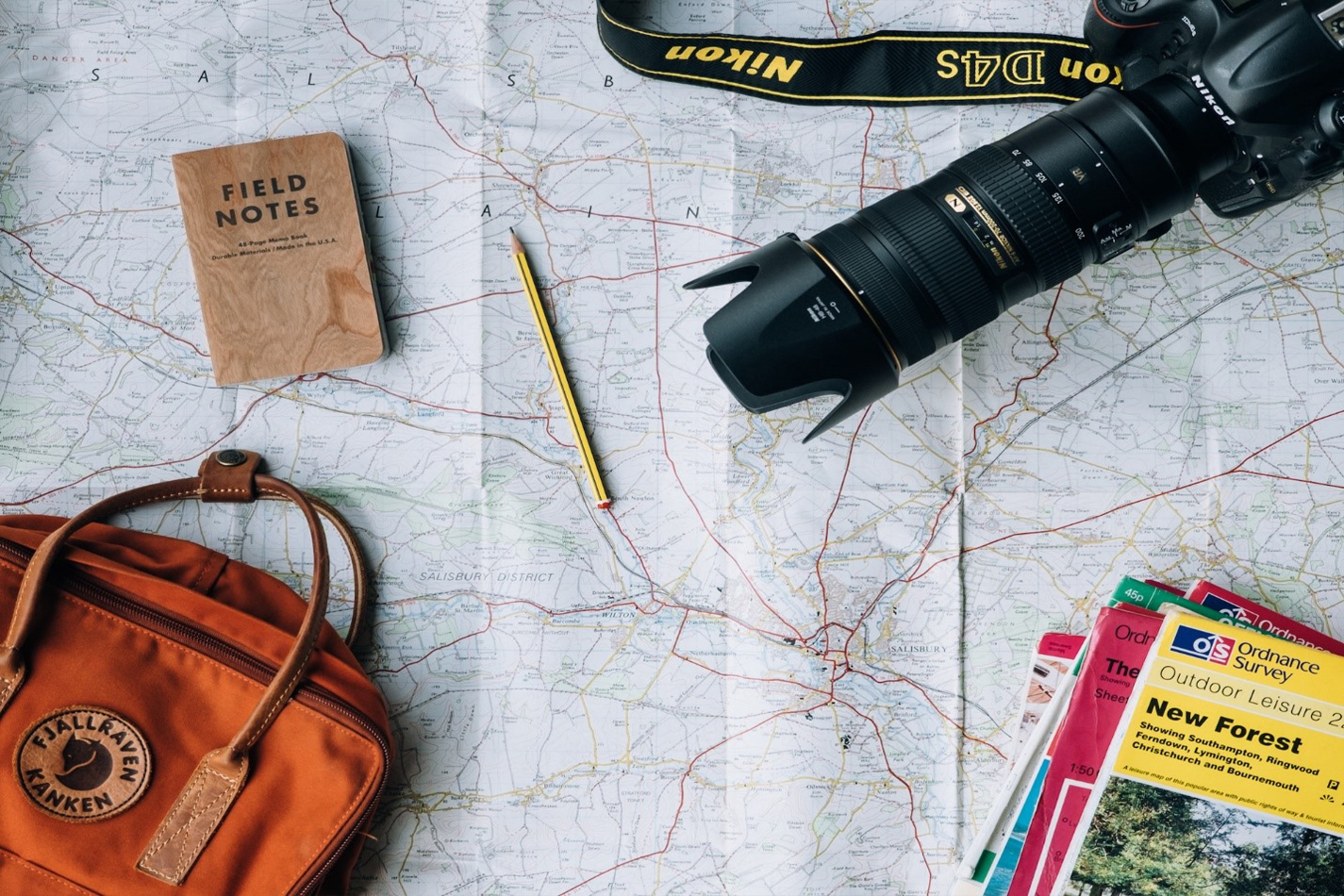
This dynamic experience offers a unique blend of tranquility and adventure. You'll paddle leisurely during the day, taking in the beauty of your surroundings, and then set up camp at night, enjoying the simplicity of life in the great outdoors. It's a fantastic way to bond with nature, challenge yourself physically, and create lasting memories with friends or family.
However, to make the most of this experience, meticulous planning is essential, which brings us to the next point.
Importance of Planning
Planning is the backbone of a successful canoe camping adventure. Whether you're a seasoned outdoor enthusiast or a novice camper, the wilderness can be unforgiving if you're ill-prepared. Proper planning ensures your safety, comfort, and enjoyment throughout the trip.
One of the primary reasons planning is crucial is safety. The wilderness can pose unexpected challenges, from sudden weather changes to unforeseen injuries. By planning ahead, you can equip yourself with the right gear, knowledge, and emergency procedures to handle these situations.
Planning also helps you make the most of your adventure. It allows you to select the ideal route, campsites, and activities, ensuring that you get the most out of your time in nature. It helps you avoid common pitfalls like running out of food or underestimating the physical demands of paddling and portaging.
It's the first step towards a successful canoe camping adventure in 2023.
Overview of Key Planning Steps
Planning a canoe camping trip involves several essential steps, each contributing to the overall success of your adventure. Here's an overview of the key planning steps you should consider:
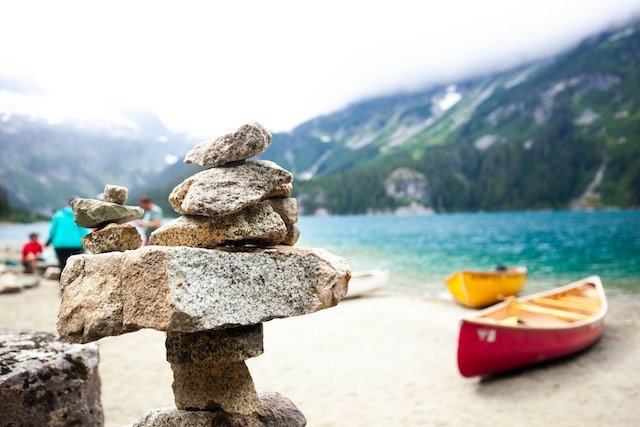
Destination Selection
Selecting the right destination is the first crucial step in planning a memorable canoe camping trip in 2023.
Start by scouring the internet, guidebooks, and travel forums for recommendations. There are numerous hidden gems waiting to be discovered, and fellow adventurers often share their experiences and insights online. Look for destinations that align with your interests and preferences. Do you seek the tranquility of a remote wilderness experience, or are you more inclined towards a picturesque lake dotted with islands? Consider factors such as the distance from your home,
travel time, and accessibility. A destination that's too far away might require a longer trip, so make sure you account for travel logistics when planning your adventure.
Pay attention to the time of year you plan to go canoe camping. Some destinations may be more appealing during specific seasons. For example, a spring trip might offer vibrant wildflowers and mild weather, while a fall excursion could provide stunning foliage and cooler temperatures.
Remember that some destinations require advanced reservations due to high demand. Ensure you secure the necessary permits well in advance, especially for popular locations.
Considering Skill Level and Experience
Your skill level and experience play a pivotal role in determining the success and enjoyment of your canoe camping trip.
If you're new to canoe camping, it's advisable to choose a destination that aligns with your beginner-level skills. Opt for calm and gentle waterways with minimal hazards. Lakes and slow-moving rivers are excellent choices for novice paddlers.
For those with intermediate or advanced skills, you have a broader range of options. You can venture into more challenging terrain, like fast-flowing rivers or coastal waters. However, always assess your comfort level and seek opportunities to expand your skills gradually.
Consider the experience of your camping companions as well. If you're traveling with a group, ensure that the chosen destination is suitable for everyone's skill levels. This ensures a safer and more enjoyable trip for all.
Remember that even experienced paddlers need to adapt to different environments. Research the specific challenges of your chosen destination. Are there portages, rapids, or unpredictable weather conditions to contend with?
Evaluating Waterway Options
Begin by assessing the type of waterways available at your chosen destination. Are you interested in serene lakes, meandering rivers, or challenging whitewater? Each type of waterway offers a distinct experience, so it's essential to align your preferences with the available options.
Consider the length and difficulty of your planned journey. Longer trips may require access to multiple waterways, each with its own characteristics. You might start on a calm lake, progress to a meandering river, and tackle challenging rapids as you go.
Look for opportunities to explore offshoots and side trips. Some waterways may lead to hidden gems such as secluded coves, waterfalls, or pristine beaches.
Checking Local Regulations and Permits
Begin by researching the specific regulations governing canoe camping in your chosen destination. These regulations can vary widely from one area to another and may include rules related to camping, fire safety, waste disposal, and wildlife protection.
Identify the agencies responsible for managing the area you plan to visit. These agencies will provide you with information on required permits, fees, and any seasonal restrictions. Be diligent in reviewing their websites, as they often contain valuable resources and updates.
Plan your trip well in advance to allow ample time for the permit application process. Some popular destinations have limited permits available, and they may be in high demand.
Once you've obtained the necessary permits, make sure to carry them with you during your canoe camping adventure.
Equipment Preparation
Creating a Comprehensive Gear Checklist
Creating a comprehensive gear checklist is the foundation of a well-prepared canoe camping trip. This essential step ensures that you have everything you need for a comfortable and enjoyable adventure.
Here's how to create an effective gear checklist: Start by categorizing your gear into essential, optional, and luxury items. Essential items include basics like a tent, sleeping bag, cooking equipment, and navigation tools. Optional items might include camp chairs or extra creature comforts, while luxury items are those that enhance your experience but
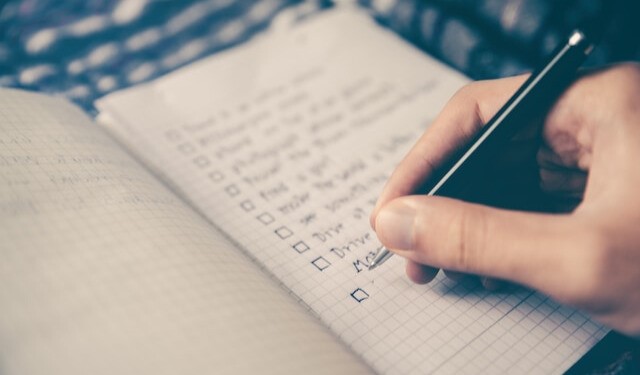
aren't strictly necessary. Consider the specific needs of your trip and destination. If you're going on a cold-weather adventure, prioritize warm clothing and a reliable sleeping bag. In contrast, a summer trip might require lightweight, breathable gear.
Think about personal items such as toiletries, medications, and personal identification. These are easy to overlook but essential for your well-being during the trip.
Once you've compiled your checklist, review it meticulously to ensure you haven't missed anything. It's also a good idea to share the checklist with your camping companions to ensure everyone is on the same page.
Renting or Purchasing Canoe and Camping Gear
Renting or purchasing canoe and camping gear is a crucial step in preparing for your canoe camping trip. The decision to rent or buy depends on various factors, including your budget, experience level, and frequency of camping. Here's how to make the right choice:
Consider the gear you already own. If you have most of the necessary equipment, renting may be a cost-effective option for items you lack. On the other hand, if you plan to go canoe camping regularly, investing in quality gear can save you money in the long run.
Research rental options in your area or at your chosen destination. Many outdoor outfitters offer gear rental services, allowing you to access high-quality equipment without the upfront cost. Be sure to reserve your gear well in advance, especially during peak camping seasons.
If you decide to purchase gear, invest in quality items that align with your specific needs. For example, a durable and lightweight canoe is essential for smooth paddling. Similarly, a reliable tent and sleeping bag are crucial for a comfortable night's rest.
Don't forget about safety equipment. Life jackets, first aid kits, and communication devices should be top priorities. These items are essential for your well-being and can't be compromised.
Inspect all gear, whether rented or purchased, to ensure it's in good condition before your trip. Test equipment like stoves, headlamps, and navigation tools to avoid unpleasant surprises during your adventure.
Ensuring Gear is in Good Condition
Start by conducting a thorough inspection of each piece of equipment. Check for any signs of wear and tear, such as frayed straps, torn tent fabric, or damaged zippers. Pay particular attention to crucial safety gear like life jackets and communication devices. Clean all gear meticulously. Tents, sleeping bags, and clothing should be cleaned according to manufacturer recommendations.
Test all equipment to ensure it functions correctly. This includes setting up your tent to check for any missing or damaged parts, testing your camp stove, and making sure your navigation tools are accurate and functioning.
Repair or replace any damaged or malfunctioning gear promptly. Additionally, familiarize yourself with basic repair skills for on-the-spot fixes in the wilderness.
Properly store your gear when not in use. Keep it in a dry, cool, and well-ventilated area to prevent mold, mildew, and degradation. Store life jackets, communication devices, and first aid kits where they are easily accessible.
Packing Strategically for Canoe Storage
Packing strategically for canoe storage is a skill that can greatly enhance the efficiency and comfort of your canoe camping trip.
Start by organizing your gear into categories, such as sleeping gear, cooking equipment, clothing, and safety items. This categorization makes it easier to access what you need when you need it.
Consider the weight distribution of your gear. Balance the load to prevent the canoe from tilting to one side. Essential items like food, water, and safety gear should be evenly distributed.
Pack gear in waterproof bags or dry sacks to protect them from water damage. Even on calm waterways, there's always a chance of splashes or rain, so waterproofing your gear is crucial.
Utilize the available storage space efficiently. Canoes typically have storage areas in the bow (front), stern (back), and sometimes in the middle. Heavier items should go closer to the center, while lighter and frequently used items can be placed near the ends for easy access.
Secure your gear with straps or bungee cords to prevent shifting during paddling. This ensures that your canoe remains stable and balanced on the water.
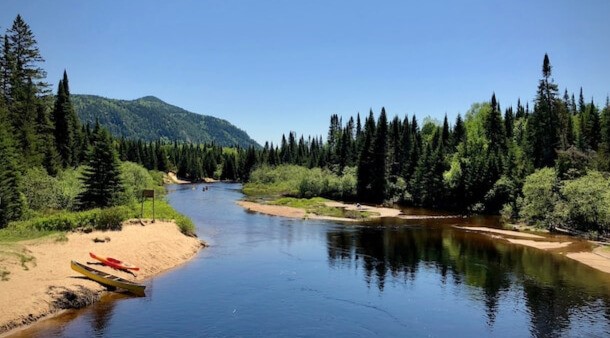
Route Planning
Mapping Out the Itinerary
It's the roadmap that guides you through your adventure, ensuring you stay on course and make the most of your journey.
Start by selecting the specific waterways or routes you plan to explore. Use topographic maps, navigation apps, or guidebooks to gain a comprehensive understanding
of the area. Highlight key landmarks, access points, and potential campsites. Break down your journey into manageable segments. Consider how far you'll paddle each day and where you'll set up camp each night. Keep in mind that canoeing can be physically demanding, so plan for realistic daily distances. Identify points of interest along the way. Are there beautiful vistas, unique geological features, or historical sites you want to visit? Incorporate these into your itinerary to make your trip more memorable.
Factor in flexibility. Nature can be unpredictable, and weather conditions, water levels, or unexpected detours may require adjustments to your itinerary. Share your itinerary with someone responsible who isn't on the trip. This person should know your planned route, estimated return date, and emergency contact information. It's a crucial safety measure in case something goes awry.
Identifying Campsites and Rest Stops
Identifying suitable campsites and rest stops is an integral part of route planning for your canoe camping trip.
Research potential campsites along your route. Look for spots that offer easy access to the water, level ground for tent setup, and proximity to necessary resources like firewood and fresh water sources.
If you Identify rest stops where you can take breaks, have lunch, or simply enjoy the scenery would really ease your life while canoeing.
Plan your daily distances to ensure that you have enough time to reach your chosen campsite or rest stop comfortably. Prioritize safety when selecting campsites and rest stops. Avoid locations prone to flooding, landslides, or other natural hazards. Be aware of the tides if you're camping near coastal areas.
Estimating Daily Distances
Estimating daily distances is a vital aspect of route planning for your canoe camping adventure. It helps you maintain a realistic pace, reach your destinations on time, and avoid overexertion. Here's how to estimate daily distances effectively:
Start by considering your physical fitness level and that of your camping companions. Be honest about your paddling abilities and stamina. This self-assessment forms the basis for your daily distance estimates.
Consult maps and navigation tools to gauge the length of your route. Pay attention to the scale and contour lines on topographic maps to get a sense of the terrain and waterway conditions.
Take into account the speed of your canoe. Different types of canoes and water conditions can affect your average paddling speed. As a general guideline, paddlers often average around 3-4 miles (5-6.5 kilometers) per hour.
Factor in the weather and water conditions. Headwinds, strong currents, or rough waters can slow your progress, so be prepared to adjust your daily distances accordingly. Plan rest breaks and meals during your paddling day. Frequent short breaks can help you maintain energy and focus. Include time for exploring points of interest along your route. Consider the time of year and available daylight. In summer, you have longer daylight hours, allowing for more paddling time. In contrast, fall and winter trips may require shorter distances due to reduced daylight.
Plan for flexibility in your daily distances. Unexpected challenges or opportunities may arise during your trip, and having some buffer in your schedule allows for adjustments.
Factoring in Weather Conditions
Factoring in weather conditions is an essential element of route planning for your canoe camping trip. Weather can significantly impact your safety and comfort on the water. Here's how to do it effectively:
Check weather forecasts regularly in the days leading up to your trip and on the morning of your departure. Consider seasonal weather patterns. Different times of the year bring different weather challenges. For example, summer may bring hot, sunny days, while fall can introduce cooler temperatures and potential rain.
Be prepared for sudden weather changes. Weather in wilderness areas can be unpredictable. Pack clothing and gear suitable for a variety of conditions, including rain gear, layers for warmth, and sun protection.
Plan your daily distances and activities with weather in mind. If strong winds or storms are forecasted, adjust your route or plan for rest days in a sheltered location. Learn to read the signs of changing weather. Cloud formations, wind patterns, and sudden temperature drops can indicate impending weather shifts. Knowing these signs can help you make informed decisions on the water.
Understand how weather can impact water conditions. Rainfall upstream can lead to rising water levels, while strong winds can create challenging paddling conditions. Stay vigilant and prioritize safety. Stay flexible with your itinerary. Weather can necessitate changes to your plans. Have backup campsites and routes in mind in case your original plans need adjustment.
Life Jackets (PFDs): Personal Flotation Devices, commonly known as life jackets, are non-negotiable. Each member of your group should have a properly fitting PFD. Make sure they are U.S. Coast Guard approved and in good condition. Always wear them while on the water.
Whistle: A whistle is a simple but effective signaling device. It can be vital for attracting attention in case of an emergency.
Throw Bag: A throw bag with a buoyant rope is crucial for water rescue situations. It allows you to reach someone in the water or secure your canoe in challenging conditions.
Bailer or Bilge Pump: These tools are used to remove water from your canoe in case it takes on water. It's essential for staying afloat in emergency situations.
Navigation Tools: Maps, compasses, and GPS devices are essential for maintaining your bearings and finding your way, especially in unfamiliar territory.
Headlamp or Flashlight: These are essential for navigating in the dark or low-light conditions and for signaling for help if necessary.
Fire-Making Tools: In an emergency, fire can provide warmth, signal for help, and purify water. Carry waterproof matches or a lighter.
Knife or Multi-Tool: A versatile tool can be invaluable for various tasks, from cutting rope to preparing food.
Tarp or Emergency Shelter: Having a lightweight tarp or emergency shelter can protect you from the elements in an unexpected situation.
Repair Kit: A repair kit for your canoe and gear can save the day if something gets damaged during your trip. Remember that your safety equipment is only effective if you know how to use it. Familiarize yourself with each item and its purpose before embarking on your trip. Safety should always come first.
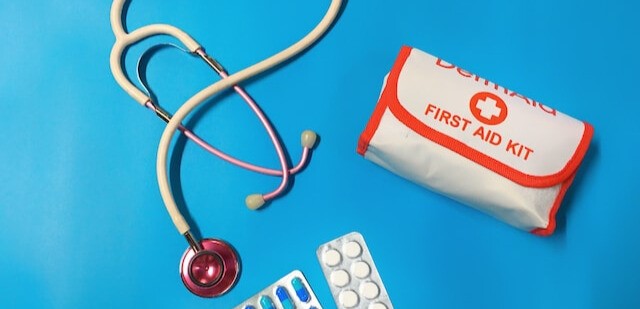
First Aid Kit and Medical Supplies
A well-equipped first aid kit and essential medical supplies are indispensable when you're canoe camping. While you hope not to use them, being prepared for injuries and illnesses is vital. Here's what you should include:
Basic First Aid Manual:
Even if you're familiar with first aid, having a manual on hand can be a helpful reference in high-stress situations.
Adhesive Bandages: These are essential for treating minor cuts, blisters, and abrasions.
Sterile Gauze and Tape: These are useful for larger wounds that require coverage and protection.
Antiseptic Wipes or Solution: Use these to clean wounds to prevent infection.
Scissors and Tweezers: For cutting tape, clothing, or removing splinters.
Pain Relievers: Include over-the-counter pain relievers for headaches, muscle aches, or pain from injuries.
Antihistamines: These can be crucial for allergic reactions or insect bites.
Prescription Medications: If you or any trip participants require prescription medications, ensure an adequate supply.
Medical Gloves: Use gloves when providing first aid to prevent infection.
CPR Mask: In the event of cardiac arrest, a CPR mask can be a lifesaver.
Emergency Blanket:These compact blankets provide warmth and shelter in emergencies. Insect Repellent and Sting Treatment: Protect against insect bites and have treatments on hand in case of stings.
Snake Bite Kit: Essential if you're in snake-prone areas.
Emergency Contact Information: Include a list of emergency contacts and medical history information for all trip participants.
Communication DevicesStaying connected and having the means to call for help when necessary is paramount during your 2023 canoe camping trip. Communication devices can be a lifeline in emergencies. Here's what you should consider:
Cell Phone:Ensure your cell phone is fully charged and stored in a waterproof case. Keep it accessible in case of emergencies. However, be aware that coverage may be limited in remote areas.
Satellite Phone: If you're venturing into extremely remote locations, consider renting or investing in a satellite phone. These devices can provide communication in areas where cell phones won't work.
Two-Way Radios: Two-way radios can be invaluable for communication within your group, especially if you're paddling in separate canoes. Make sure everyone knows how to use them and establish a clear communication protocol.
Personal Locator Beacon (PLB): PLBs are emergency devices that, when activated, transmit your location to search and rescue authorities. Register your PLB before your trip and know how to use it.
Emergency Whistle: A loud whistle is a simple but effective tool for signaling for help, even in noisy or windy conditions.
Flares or Signal Mirror: These can be useful for attracting attention in emergencies, especially if you're in a remote location.
GPS Device: A GPS device can help you navigate and relay your coordinates in case of an emergency.
Emergency Contacts and Procedures
Emergency Contact List:
Create a detailed list of emergency contacts, including local authorities, park rangers, and trusted friends or family members who can assist if needed.
Trip Itinerary Sharing:
Before your trip, share your complete itinerary, including your planned route, campsite locations, and estimated return date, with someone who is not on the trip. This person should know when and how to contact authorities if you don't check in as planned.
Emergency Procedures:
Discuss emergency procedures with your group before you start your trip. Ensure everyone knows how to use safety equipment, communication devices, and emergency signals like whistles or flares.
Lost or Separated Procedures:
Establish protocols for what to do if someone becomes lost or separated from the group. Agree on a meeting point and actions to take in case of separation.
Medical Emergencies:
Develop a plan for dealing with medical emergencies. Ensure that someone in your group is trained in basic first aid and CPR. Share information about any medical conditions or allergies with the group.
Stay Calm and Assess:
In an emergency, it's crucial to stay calm and assess the situation. Panic can lead to poor decision-making. Follow your emergency procedures and prioritize safety.
Activation of Emergency Devices:
Know when and how to activate emergency devices like personal locator beacons (PLBs) or satellite phones. These devices can be lifesavers in dire situations.
Regular Check-Ins:
Establish regular check-in times with your emergency contacts. This can be daily or at specific intervals during your trip. Failing to check in should trigger a response.
Food and Water Planning
Meal Planning and Packing
Proper meal planning can make your adventure more enjoyable and eco-friendly. Here's what you need to know:
Plan Meals in Advance:
Decide what meals you'll have each day of your trip. Consider dietary restrictions and preferences of your group members. Plan for balanced meals that provide the necessary energy for paddling and camping.
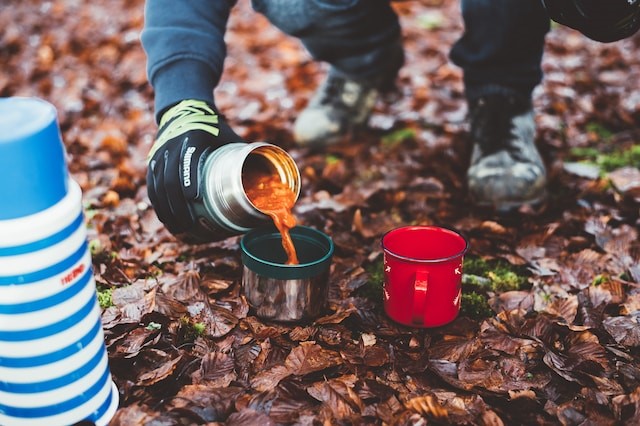
Pre-Pack Ingredients:
Pre-pack ingredients for each meal in separate, waterproof containers or bags. This ensures you have the right portions and reduces waste.
Opt for Lightweight and Non-Perishable Foods:
Choose lightweight, non-perishable foods like dehydrated meals, trail mix, nuts, and dried fruits. These foods are easy to pack and have a long shelf life.
Consider Fresh Foods Carefully:
If you plan to bring fresh foods like fruits and vegetables, pack them in protective containers to prevent bruising or spoilage. Consume these items early in your trip.
Use Reusable Containers:
Reduce waste by using reusable containers for meals and snacks. These containers should be airtight to keep food fresh and waterproof to prevent water damage.
Plan for Special Diets:
If anyone in your group has special dietary requirements, ensure you have suitable food options. It's essential to accommodate allergies or dietary restrictions.
Calculate Portions:
Avoid over-packing by calculating portion sizes accurately. Plan for an extra day or two in case your trip is extended.
Minimize Packaging:
Remove excess packaging from store-bought items before packing. This reduces waste and saves space.
Cooking Equipment:
Bring lightweight, compact cooking equipment such as a camp stove and cookware suitable for your meals. Ensure you have enough fuel for the duration of your trip.
Pack a Trash Bag:
Bring a designated trash bag to collect and carry out all waste. Leave no trace by disposing of waste properly when you return.
Water Purification Methods
Access to safe drinking water is essential during your 2023 canoe camping trip. However, natural water sources may not always be safe to drink. Knowing effective water purification methods is crucial. Here's what you should consider:
Boiling:
Boiling water is one of the most reliable methods to purify it. Heat water to a rolling boil for at least one minute (longer at higher altitudes) to kill harmful microorganisms.
Water Filters:
Portable water filters are compact and effective at removing bacteria and protozoa. Choose a filter that suits your needs and follow the manufacturer's instructions for use.
Chemical Treatment:
Water purification tablets or drops containing chlorine or iodine can be used to disinfect water. Follow dosage instructions carefully and allow adequate contact time.
UV Sterilizers:
UV sterilizers use ultraviolet light to kill microorganisms in water. These devices are lightweight and quick, but they require batteries or a power source.
Pump Filters:
Hand-operated pump filters are effective at removing contaminants. However, they can be bulkier and may require more effort to use.
Pre-filtering:
Pre-filter water through a cloth or coffee filter to remove larger particles before using other purification methods. This can extend the life of filters and improve water clarity.
Collect Water from Safe Sources:
Whenever possible, collect water from flowing sources like rivers or streams, as they are less likely to contain stagnant water and contaminants.
Carry Adequate Water:
Plan your water needs carefully and carry enough water for your journey, especially if you're traveling through areas with limited water sources.
Storage of Food and Trash
Proper storage of food and trash during your canoe camping trip is crucial for several reasons. It protects your food from wildlife, reduces litter, and helps maintain a pristine environment. Here's how to handle food and trash storage effectively: In bear country, use bear canisters or bear bags to store food. These containers are designed to prevent bears and other wildlife from accessing your food.
Use airtight containers for storing food to prevent odors from attracting animals. Ziplock bags and plastic containers with secure lids are good options. Keep food and trash separate at all times. Dispose of trash properly to prevent animals from associating your campsite with a food source.
Bring a designated trash bag for collecting and carrying out all waste. Ensure it's waterproof and secure. Follow a strict "pack it in, pack it out" policy. Everything you bring with you should leave with you, including trash and food scraps.
Wash dishes and cooking utensils away from your campsite, preferably at least 200 feet from water sources. Use biodegradable soap, if possible. Greywater, or dishwater, should also be disposed of away from water sources. Strain food particles before disposing of greywater.
Use Campground Facilities: If you're camping in established campgrounds, use designated trash containers and follow campground rules.
Educate Your Group: Ensure that everyone in your group understands the importance of proper food and trash storage and follows the guidelines diligently.
Leave No Trace: Abide by Leave No Trace principles, which include minimizing your impact on the environment and preserving the wilderness for future generations.
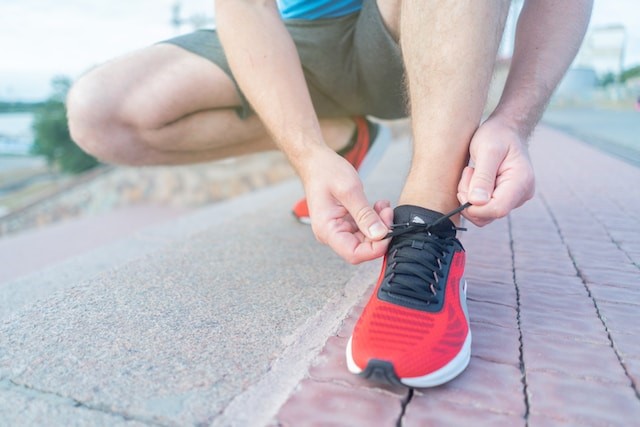
Physical Preparation
Fitness and Endurance Training
Physical fitness and endurance play a significant role in your enjoyment and safety during a canoe camping trip. Paddling and portaging require strength and stamina. Engage in cardiovascular exercises like running, cycling, or swimming to improve your endurance. Aim for at least 30 minutes of aerobic activity on most days. A strong core is essential for stability and balance in a canoe. Include core-strengthening exercises like planks, Russian twists, and leg raises in your routine.
Incorporate strength training exercises that target your core, upper body, and legs. These exercises help you paddle effectively and carry gear during portages. Include stretching exercises to maintain flexibility and prevent muscle strains. Stretch your arms, back, and legs regularly.
If possible, practice paddling in conditions similar to those you'll encounter during your trip. If your trip includes portaging, simulate portaging conditions by hiking with a weighted backpack.
Balance and Coordination: Develop balance and coordination, which are crucial for stability in a canoe. Activities like yoga or stand-up paddle boarding can help improve these skills. Maintain a balanced diet to provide your body with the necessary nutrients for energy and muscle recovery. Stay hydrated to prevent cramps and fatigue. Start your training well in advance of your trip and gradually increase the intensity and duration of your workouts. This prevents overexertion and reduces the risk of injury.
Paddling Techniques
Proper Grip: Hold your paddle correctly by gripping it with both hands, keeping them shoulder-width apart. Your top hand should be on the throat of the paddle, while the bottom hand should be near the blade.
Forward Stroke: The forward stroke is the most basic and essential. Reach forward with the paddle blade, immerse it fully in the water, and pull it back alongside the canoe. Rotate your torso for power.
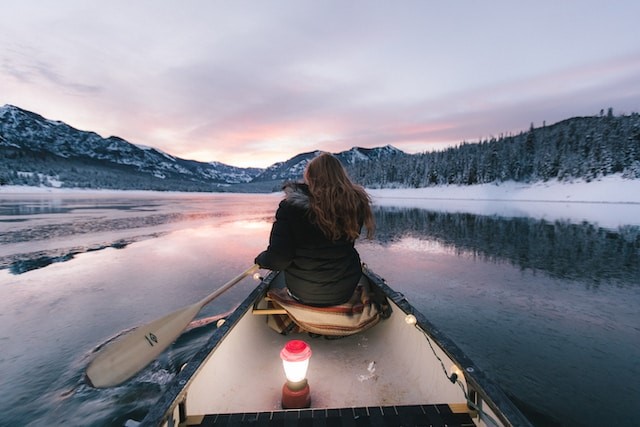
Reverse Stroke: The reverse stroke helps you move backward. Reach behind you with the paddle blade, immerse it fully, and push it away from the canoe. Use your core muscles for power.
J Stroke: The J stroke is a corrective stroke used to maintain a straight course. After the forward stroke, turn the blade outward and make a slight "J" shape at the end of your stroke, which corrects the canoe's direction.
Draw Stroke: The draw stroke moves the canoe sideways. Reach out to the side and pull the water toward the canoe. This is useful for maneuvering in tight spaces or making quick adjustments.
Sweep Stroke: The sweep stroke is a wide, sweeping motion used for turning the canoe. Extend your paddle to the side, submerge the blade, and sweep it in a wide arc.
Paddle in Tandem: If you're paddling with a partner, coordinate your strokes for efficient paddling. Communication and synchronization are key. Regularly practice these techniques and drills to improve your paddling skills. Paddle in calm waters to master the basics before tackling challenging conditions. Always wear your life jacket while paddling, and be aware of your surroundings. Know how to execute a wet exit and re-entry in case of capsizing.
Portaging Practice
Portaging, the act of carrying your canoe and gear over land to bypass obstacles, is a common part of canoe camping trips. Portage pads or yokes are specialized equipment that helps distribute the weight of the canoe more comfortably on your shoulders. Ensure your canoe has a well-fitted yoke. When lifting the canoe, bend your knees and keep your back straight. Lift with your legs, not your back, to avoid strain. Distribute gear evenly in the canoe to maintain balance during portages. This makes the canoe easier to carry.
If you're portaging with a group, coordinate your efforts. Communicate clearly and use teamwork to transport the canoe efficiently. Before portaging, scout the trail and plan your route. Look for obstacles, steep sections, or tricky terrain. Choose the path of least resistance. Carry essential gear with you during portages, such as water, snacks, a map, and first aid supplies. Keep these items in a small daypack. Take breaks during long portages to rest and hydrate. Listen to your body and avoid overexertion.
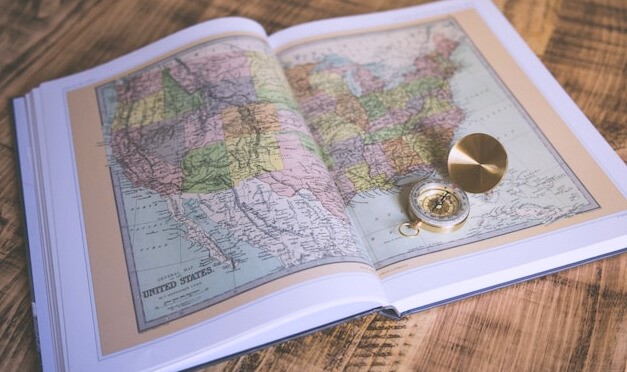
Navigation Skills
Understanding Map and Compass Navigation
Map and compass navigation is an essential skill for any canoe camper. It allows you to navigate confidently, even in areas without GPS signal. Begin by studying topographic maps of your canoe camping area. Topo maps provide detailed information about terrain, elevation, water bodies, and landmarks. Understand the map's legend and symbols. Learn how to use a compass to determine direction.
The compass needle points to magnetic north, which you can use to orient yourself on the map. Align the map with the compass so that its north corresponds to magnetic north. This ensures that your map and surroundings are in sync.
Account for declination, which is the angle between magnetic north and true north. Always carry backup maps and a spare compass. Protect maps from water damage by using waterproof map cases or storage bags.
Invest in a reliable GPS device designed for outdoor use. These devices offer accurate positioning, waypoint marking, and track recording. Download navigation apps on your smartphone or tablet. Use GPS devices and apps to mark waypoints, including campsites, landmarks, and emergency exit points. Bring extra batteries or a portable charger for your GPS device or smartphone. Extended use of GPS can drain batteries quickly.
Reading Water and Currents
Familiarize yourself with different types of water bodies you may encounter, such as rivers, lakes, and ponds. Learn about the flow of water, including currents in rivers and tides in coastal areas. Understand how they can affect your canoe's movement. Assess water depth to avoid shallow areas, especially when paddling in rocky or narrow sections. Shallow water can damage your canoe.
Look out for submerged rocks, fallen trees, or other obstacles that can pose hazards to navigation. Be aware of the effects of wind on water. Wind can create waves and alter your course. Pay attention to the direction of water flow. This is particularly important in rivers, where the current can impact your maneuverability.
Landmarks and Waypoints
Landmarks and waypoints are essential for navigation and orientation during your canoe camping trip. Learn to identify prominent landmarks such as distinctive trees, rock formations, or buildings that can serve as reference points on your route. Use your map, GPS device, or navigation app to mark waypoints for key locations like campgrounds, put-in and take-out spots, and potential hazards.
Natural landmarks like mountain peaks, lakeshores, and distinctive bends in rivers can be reliable reference points for navigation. Man-made landmarks like bridges, buoys, or cabins can also be helpful for orientation, especially in areas with limited natural landmarks. During Canoeing and portaging take help form these landmarks. Record GPS coordinates for critical waypoints to ensure accuracy in your navigation. These coordinates can be programmed into your GPS device or app.
Environmental Awareness
Thoroughly plan your trip to minimize surprises. Consider factors like weather, regulations, and group size. Proper planning reduces the likelihood of accidents and minimizes impact.
Stick to established trails, campsites, and portage routes to prevent soil erosion and vegetation damage. Avoid creating new paths or trampling on fragile ecosystems. Preserve the natural beauty and cultural or historical artifacts of the area. Observe animals from a distance, avoid feeding them, and store food securely to prevent wildlife encounters.
Keep noise levels down, yield the trail to others, and maintain a friendly and respectful attitude towards fellow outdoor enthusiasts. When encountering wildlife, maintain a safe and respectful distance. Use binoculars or a camera with a zoom lens to get a closer look without disturbing animals. Respect designated areas where wildlife is protected or where human access is restricted to preserve fragile ecosystems Clean up your campsite thoroughly after meals. Dispose of food scraps and trash properly to avoid attracting wildlife.
Responsible Campfire Practices
Campfires can be a delightful part of camping, but they should be enjoyed responsibly to minimize their impact on the environment. Before lighting a campfire, check local regulations and restrictions. In some areas, fires may be prohibited due to fire danger or environmental concerns.
If fires are allowed, use established fire rings or fire pans. Keep fires small and manageable. Use small sticks and twigs for fuel rather than large logs. Never leave a campfire unattended. Ensure it is completely extinguished before leaving your campsite or going to sleep. Consider using a camp stove for cooking instead of making a fire. If there's a fire ban in effect, adhere to it strictly.
Waste Disposal and Clean-up
Proper waste disposal and clean-up are essential to maintain the pristine beauty of nature while canoe camping. Carry out all trash, including food wrappers, used tissues, and hygiene products. Use a portable toilet or dig a cat hole at least six inches deep, well away from water sources and trails.
Dispose of wastewater from cooking, cleaning, and personal hygiene at least 200 feet away from water bodies. Don't use soap directly in natural water bodies, as it can harm aquatic life. Use designated recycling and trash bins in established campgrounds or recreation areas. Encourage your fellow campers to follow responsible waste disposal and clean-up practices.
Group Dynamics
Selecting Camping Companions
Choosing the right camping companions is crucial for a harmonious and enjoyable canoe camping experience Look for companions who share your enthusiasm for canoe camping and the outdoors. Consider the skill levels of your companions. Try to choose individuals with compatible personalities.
Consider the ideal group size for your trip. Smaller groups may be more intimate and easier to manage, while larger groups can provide more diversity and shared responsibilities. Assess the experience and expertise of your companions. Having individuals with diverse skills, such as first aid knowledge or navigation skills, can be valuable. Ensure that all members of the group are in good health and have the physical fitness required for the trip.
Consider delegating specific roles and responsibilities to each member of the group based on their skills and interests. Make sure that all members of the group are aware of emergency procedures and have the necessary equipment, such as first aid kits and communication devices.
Delegating Responsibilities
Begin by having a group discussion to identify the various tasks and responsibilities required for the trip. This can include navigation, cooking, setting up camp, and first aid. Assess the strengths, skills, and interests of each group member. Delegate tasks based on individual expertise and preferences.
Consider rotating responsibilities to give everyone a chance to participate in different aspects of the trip. This can prevent burnout and foster a sense of teamwork. Designate leadership roles, such as trip leader or navigator. Ensure that the leaders are knowledgeable and capable of making decisions in the best interest of the group. Assign specific safety-related responsibilities, such as checking the weather forecast, monitoring water conditions, and overseeing first aid and emergency procedures.
Collaborate on meal planning and cooking responsibilities. Distribute cooking duties among group members, and ensure that dietary preferences and restrictions are considered. Delegate responsibilities for equipment maintenance and gear organization. Each person should be responsible for their personal gear, and additional tasks can include setting up tents, filtering water, and packing the canoe.
Conflict Resolution Strategies
Conflict resolution is essential for maintaining harmony within a camping group. Encourage open and respectful communication within the group. Create a safe space where members can express their concerns and feelings.
Practice active listening by giving each person the opportunity to share their perspective Encourage everyone to remain calm during conflicts. Emotions can run high in outdoor settings, but maintaining composure is crucial for effective resolution. Deal with conflicts as they arise rather than letting them fester. Addressing issues promptly prevents them from escalating.
Encourage group members to find common ground and seek compromise when possible. A win-win solution is often the best outcome. If conflicts persist, designate a mediator within the group to facilitate discussions and help find resolutions.
Acknowledge and respect individual boundaries and personal space. Sometimes, conflicts arise from a lack of consideration for personal preferences. Shift the focus from the problem to potential solutions. Brainstorm together to find practical and mutually agreeable resolutions.
Maintaining Group Morale
Maintaining high group morale is essential for a positive and enjoyable canoe camping experience. Here are strategies to keep spirits high: Create a positive and inclusive atmosphere within the group. Encourage humor, laughter, and camaraderie. Engage in team-building activities and games to strengthen bonds and create shared experiences.
Acknowledge and celebrate achievements, milestones, and successful navigation of challenges during the trip. Distribute responsibilities fairly so that no one feels overwhelmed. Rotate tasks to prevent burnout.
Encourage group members to support and help each other. Address conflicts promptly and effectively to prevent them from negatively impacting group morale.
Legal Considerations
Permits and Regulations
Determine if you need permits for camping, campfires, or specific activities like fishing or hunting. Some areas may limit the number of permits issued each day to protect the environment. If permits are required, familiarize yourself with the application process. Some permits can be obtained online, while others may need to be acquired in person or well in advance. Follow all regulations and guidelines stipulated by the permits.
Some areas may have seasonal closures to protect wildlife during breeding seasons or to reduce fire risk. Respect these closures for the well-being of the ecosystem. Ensure that all members of your group are aware of the permit requirements and regulations. Everyone should be committed to complying with them.
Emergency Response Procedures
Create a list of emergency contacts, including local authorities, park rangers, and medical facilities. Distribute this list to all members of your group. Carry communication devices such as satellite phones, two-way radios, or Personal Locator Beacons (PLBs) that work in remote areas without cellular coverage.
Establish a set of emergency signals or codes that the group can use to communicate distress or urgent situations. Ensure that at least one member of your group is trained in first aid and CPR. Carry a well-equipped first aid kit and know how to use it. Keep an eye on weather conditions and be prepared for sudden changes. Know how to react to storms, high winds, or other adverse weather events.
Familiarize yourself with map and compass navigation and GPS devices. In case of getting lost, these skills can help you find your way back. Emphasize the importance of staying calm during emergencies. Panic can exacerbate the situation and hinder rational decision-making. Carry emergency shelter and insulation (such as space blankets) to protect against exposure to extreme weather conditions.
Knowing Local Laws
Research and familiarize yourself with the laws and regulations of the area you plan to visit. These can include state, federal, and local ordinances. In addition, fire regulation, fishing and hunting, wildlife protection, Campsite Reservation, Campsite Restrictions, boating regulations, and permit compliance are some of the areas that need to be respected during canoeing camping.
Budgeting and Expenses
Estimating Trip Costs
Determine the cost of getting to your starting point and returning home. This includes fuel, plane tickets, or any other means of transportation. Research the required permits, camping fees, and any park entrance fees. Include these expenses in your estimate.
Account for the cost of purchasing or renting any equipment and gear you'll need, such as canoes, tents, sleeping bags, cooking equipment, and navigation tools. Estimate the cost of food and water for the duration of your trip. Consider meal planning and any specialized dietary requirements.
If you plan to stay in lodges, cabins, or hotels before or after your canoe camping trip, include these expenses in your budget. Budget for emergency supplies, including first aid kits, communication devices, and any safety gear required for your trip.
If your canoe camping trip involves transportation within the trip itself (e.g., shuttles, boat rentals), include these costs in your estimate. Allocate funds for miscellaneous expenses like toiletries, camping permits, and any unexpected costs.
Setting a Budget
Setting a budget for your canoe camping trip is essential to manage your expenses effectively. Sump up all the estimated costs you calculated in the previous step to determine your total budget. This is your baseline. Prioritize your expenses based on what's essential and what's optional.
Break down your budget into categories like transportation, permits, food, and gear. Allocate a portion of your budget as an emergency fund. Look for discounts, deals, and group rates on permits, equipment rentals, and transportation. You can take advantage of the budget applications for easy tracking and recording.
Identifying Cost-Saving Opportunities
Identifying cost-saving opportunities is a smart way to make the most of your budget for your canoe camping trip. Here are some tips: If you don't plan to canoe camp regularly, consider renting expensive gear like canoes and tents.
If traveling with a group, inquire about group discounts for permits, transportation, and accommodations. Consider traveling during the shoulder season or off-peak times.
Plan your meals in advance and bring non-perishable, lightweight, and energy-dense foods. Utilize local resources for fishing and foraging. Buy food items in bulk before your trip to take advantage of cost savings. Minimize waste by packing items in reusable containers.
Keeping Track of Expenses
Maintaining a record of your expenses during your canoe camping trip is crucial for financial accountability. Here's how to keep track: Start an expense log or use a budgeting app to record all expenditures, no matter how small. Include the date, item purchased, and amount spent. Organize your expenses into categories, such as transportation, food, permits, and gear.
Weather and Seasonal Factors
Understanding Seasonal Variations
Understanding seasonal variations is crucial for planning a successful canoe camping trip. Here's how to adapt to different seasons: Research the seasons of your chosen destination thoroughly. Different seasons can bring varying weather conditions, wildlife behavior, and levels of human activity. Think about your comfort preferences. Some campers enjoy the warmth of summer, while others prefer the solitude of the off-season.
Understand how seasons affect wildlife and flora. Spring may offer blossoming flowers and active wildlife, while fall could bring vibrant foliage. Be aware of peak tourist seasons, as some canoe camping areas may be crowded during certain times. Consider whether you prefer solitude or a more social experience. Learn about the typical weather patterns of each season. This includes temperature ranges, precipitation levels, and the likelihood of storms.
Research how seasonal variations affect water levels in rivers, lakes, and waterways. Consider the prevalence of insects like mosquitoes and blackflies in different seasons. Bug season can significantly impact your comfort. Take into account the number of daylight hours in each season. Tailor your gear and clothing to suit the season.
Checking Weather Forecasts
.Use reputable weather forecasting sources, such as the National Weather Service or local meteorological agencies. Look for forecasts specific to your camping location. Smartphone apps can also provide up-to-date information. Pay attention to details like temperature, precipitation, wind speed, and direction.
Stay informed about storm alerts, severe weather warnings, and potential hazards like thunderstorms, strong winds, or heavy rainfall.
Build flexibility into your trip itinerary to accommodate changing weather conditions. Having alternate plans or rest days can be invaluable. Share your planned route and expected return date with a trusted friend or family member. Provide them with contact information for local authorities in case of emergencies.
Preparing for Rain or Inclement Weather
Preparing for rain or inclement weather is essential to stay dry and comfortable during your canoe camping trip. Here's how to do it: Invest in high-quality rain gear, including waterproof jackets, pants, and footwear. Ensure your rain gear is breathable to prevent moisture buildup. Use dry bags or waterproof containers to protect your gear, clothing, and important documents from getting wet.
Tarp or Shelter: Carry a lightweight tarp or portable shelter that can be quickly set up to provide a dry space for cooking or taking refuge during rain. Apply waterproofing products to your tent, backpack, and other gear to enhance their water resistance.
Clothing Layers: Pack clothing in layers, including moisture-wicking base layers to keep you dry, insulating layers for warmth, and waterproof outer layers.
Always prioritize staying dry. Change into dry clothing if you get wet, as wet clothes can lead to hypothermia, even in mild temperatures.
Campsite Selection: When setting up camp, choose a site that is well-drained and elevated to avoid pooling water and mud during rain. Be cautious with fires during wet conditions. Carry waterproof matches or a fire starter, and have a backup cooking method like a camp stove. Rain can obscure trails and landmarks. Maintain good navigation skills and have reliable maps and compasses.
Adjusting Plans for Seasonal Challenges
Create a flexible itinerary that allows for adjustments based on seasonal challenges. Be ready to alter your route or schedule if necessary. Prioritize safety over sticking to your original plan. If seasonal challenges pose a significant risk, consider postponing or canceling your trip.
If you're new to seasonal challenges like winter camping or torrential rain, consider seeking guidance from experienced outdoor enthusiasts. Maintain a positive mindset even when facing seasonal challenges. A can-do attitude can make a significant difference.
Pre-Departure Checklist
Final Gear Inspection
Check Equipment: Lay out all your camping equipment and gear and inspect each item carefully. Look for any signs of wear, damage, or malfunction. Test equipment like stoves, lanterns, and navigation devices to ensure they are in working order. Replace or repair any faulty items.
Conduct any necessary repairs or maintenance. This might include patching up tents, replacing worn-out straps, or lubricating zippers. If you'll encounter wet conditions, reapply waterproofing treatment to gear like rain jackets and tent rainflies. Examine your first aid kit to ensure it's well-stocked and that all items are within their expiration dates.
Clean your gear thoroughly, especially if it has been in storage. Dirty gear can attract pests and compromise functionality. Organize gear in a systematic manner, so it's easy to access when needed. Consider using color-coded stuff sacks or labels.
Use a comprehensive equipment checklist to ensure you haven't forgotten any essential items. Tick off each item as you pack it. Pack spare parts or repair kits for critical equipment, such as tent pole repair sleeves or replacement buckles.
Conduct a final check of your gear before departure. This minimizes the chances of discovering issues once you're in the wilderness. By conducting a thorough gear inspection, you'll be well-prepared and equipped for your canoe camping adventure.
Informing loved ones of your itinerary is a safety measure that provides peace of mind for both you and your family during your canoe camping trip Share contact information for the park ranger or relevant authorities in the area where you'll be camping.
If you're traveling with others, make sure your loved ones know the names and contact information of your companions. Share any relevant medical information, allergies, or medications with your emergency contacts.
